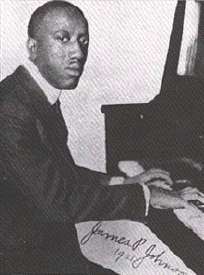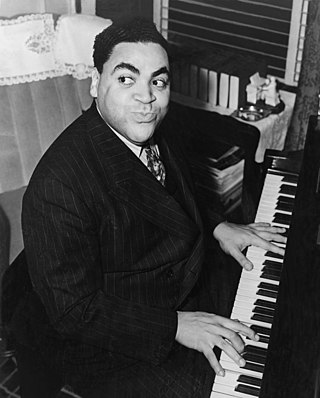Related Research Articles

Ragtime, also spelled rag-time or rag time, is a musical style that had its peak from the 1890s to 1910s. Its cardinal trait is its syncopated or "ragged" rhythm. Ragtime was popularized during the early 20th century by composers such as Scott Joplin, James Scott, and Joseph Lamb. Ragtime pieces are typically composed for and performed on piano, though the genre has been adapted for a variety of instruments and styles.

Scott Joplin was an American composer and pianist. Dubbed the "King of Ragtime", he composed more than 40 ragtime pieces, one ragtime ballet, and two operas. One of his first and most popular pieces, the "Maple Leaf Rag", became the genre's first and most influential hit, later being recognized as the quintessential rag. Joplin considered ragtime to be a form of classical music meant to be played in concert halls and largely disdained the performance of ragtime as honky tonk music most common in saloons.

James Price Johnson was an American pianist and composer. A pioneer of stride piano, he was one of the most important pianists in the early era of recording, and like Jelly Roll Morton, one of the key figures in the evolution of ragtime into what was eventually called jazz. Johnson was a major influence on Count Basie, Duke Ellington, Art Tatum, Thelonious Monk, and Fats Waller, who was his student.

Stride jazz piano, often shortened to stride, is a jazz piano style that arose from ragtime players. Prominent stride pianists include James P. Johnson, Willie "the Lion" Smith, Fats Waller, Luckey Roberts, and Mary Lou Williams.
J. Lawrence Cook was an American pianist. His output has been estimated at between 10,000 and 20,000 different roll recordings.
Reuben Bloom was an American songwriter, pianist, arranger, band leader, recording artist, vocalist, and author.

Thomas Million John Turpin was an American composer of ragtime music. Turpin is credited with the first published rag by an African American, his "Harlem Rag" of 1897.

Edward Elzear "Zez" Confrey was an American composer and performer of novelty piano and jazz music. His most noted works were "Kitten on the Keys" and "Dizzy Fingers." Studying at the Chicago Musical College and becoming enthralled by French impressionists played a critical role in how he composed and performed music.

Novelty piano is a genre of piano and novelty music that was popular during the 1920s. A successor to ragtime and an outgrowth of the piano roll music of the 1910s, it can be considered a pianistic cousin of jazz, which appeared around the same time. "Nola," a 1915 composition by New York pianist Felix Arndt, is generally considered the first novelty piano hit. Many early novelty composers were piano roll artists from the Chicago area, where two of the largest piano roll companies, QRS and Imperial, were based. While often only lightly syncopated or lacking syncopation entirely, novelty piano influenced the evolution of jazz. It is distinct from stride piano, which was developed in New York at about the same time.
Lou Busch was an American record producer, musician and songwriter, best known for performing, as a pianist under the pseudonym Joe "Fingers" Carr.

Marvin E. Ashbaugh was an American jazz pianist.
Reginald R. Robinson is an American jazz and ragtime pianist. In 2004, he received a MacArthur Genius Grant.
Clarence Homer Woods was an early American ragtime composer.

The "Black and White Rag" is a 1908 ragtime composition by George Botsford.

Arthur Schutt was an American jazz pianist and arranger.

Earl Bunn Fuller was a pioneering American ragtime and early jazz bandleader, composer and instrumentalist. Fuller helped to initiate the popularity of jazz in New York City shortly before America's entry into World War I. He also had an ear for talent, and discovered Ted Lewis and Teddy Brown.
Lincoln Mayorga was an American pianist, arranger, conductor and composer who worked in rock and roll, pop, jazz and classical music.

"Sensation Rag" or "Sensation" is a 1918 jazz instrumental by the Original Dixieland Jazz Band. It is one of the earliest jazz recordings. It is not related to Joseph Lamb's 1908 "Sensation Rag", which is a ragtime piano piece.
Axel Waldemar Christensen was an American composer, arranger, publisher, pianist and music instructor. He was the founder of the Christensen School of Popular Music, under which he published various instruction books about the playing of syncopated music. The school enrolled upwards of 500,000 students in its numerous branches across the United States, making it one of the first and most successful examples of standardizing the instruction of popular music. The school also published the music magazine 'Christensen Ragtime Review'. His formal attire and preference for grand pianos gave him the vaudeville title 'Czar of Ragtime'.
References
- Bluin' the Black Keys [usurped] MIDI file (arranged by John Roache
- Jasen, David A.; Trebor Jay Tichenor (1989). Rags and Ragtime: A Musical History . Dover. p. 233. ISBN 0-486-25922-6.